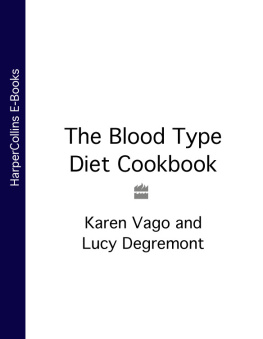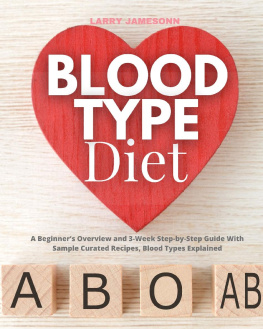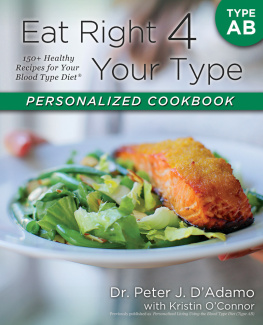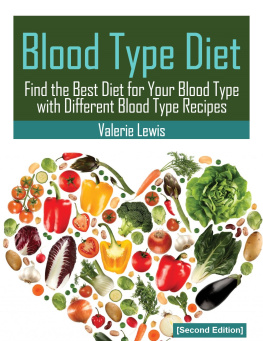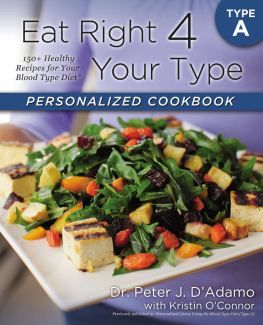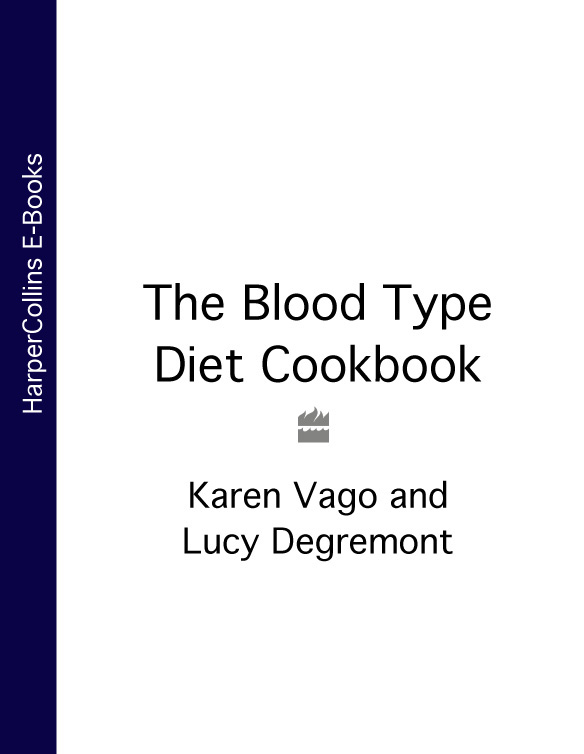
The Blood Type Diet Cookbook
Karen Vago & Lucy Degrmont
Over 100 fresh & delicious recipes to transform your health & your life!

To Madeleine where all started and to Pauline,
Philip and Thomas where all continues
Lucy Degrmont
To Michel
Karen Vago
This book has taken a long time to come to fruition. Over the years the idea behind it gradually blossomed, shaped by our observations of both gourmet cook books and health cook books. We felt there was a gap between the two aspects of eating pleasure and health. We hope this book will bridge that gap.
Twenty years ago we were young mothers, each with three children, and in both our families one child had severe allergy problems. This motivated us to find curative solutions: one of them being nutrition. Our interest duly kindled, we went on to study nutrition (Karen) and gourmet cuisine (Lucy).
Shared passions have led to shared knowledge and during the past three years we have become increasingly interested in the science of eating according to ones blood group. Members of our families, friends and patients have all been reaping the benefits of this fundamental research, brought to light by Dr Peter DAdamo. The results we have witnessed have been truly amazing and we feel privileged to be sharing this knowledge and our experience through these recipes.
For the past four seasons we have regularly left our respective family lives for cooking sessions in the Loire valley. We spent time with the producers of goats cheese, we followed the aroma of summer strawberries to the fields where they were grown, we visited a small organic yogurt plant surrounded by big yellow sunflowers. We went completely over the top during the wild game season and marinated, stuffed and roasted everything from deer to partridges. We gathered fruit from the trees, little yellow plums to large pear-sized quinces, hazelnuts and walnuts. The days flew by in planning, shopping, researching, creating, measuring, cooking, writing, eating and sharing our food. We did it all ourselves and loved every minute of it.
Each season directed the choice of produce we used for our recipes as we feel nature provides chronobiologically what we need: in the summer friends gave us vegetables from their gardens, and in the autumn fruits from their trees and game from their forests. We believe in cooking with the freshest possible produce, using plenty of vegetables, fruit, free-range poultry, wild game (which by essence is organic), meat without hormones, wild fish if possible, herbs, spices and the finest quality oils.
Our recipes cover a wide range and include soups, salads, vegetables, goats cheese, fish, poultry and game, meat, tofu and tempeh, sauces, desserts, drinks, festive dishes, Christmas and basic recipes. Each recipe is accompanied by blood type recommendations and, where appropriate, scientifically tested and traditionally proven dietary information about one of the main ingredients.
Tempting as it may be to jump straight in and try the recipes, do read the following chapter on blood types first. This provides background information on the origin of blood types, how our blood type can affect our health and how it interacts with the food we eat. Food recommendations are also given and these are complemented by the food lists, which provide a further guide on what each blood group should and should not eat.
To get you started we have created one week of menus for each season and for each blood type. In addition we felt it useful for you to have seven days of menus appropriate for all blood types. This will allow you to occasionally feed all blood groups at your table. The menus can be found at the back of the book, along with the recipe list that allows you to tell, at a glance, which recipe is suitable for which blood type. And for anyone still unsure of the benefits of following the diet we have included case histories for each blood type these real life experiences are from patients who have experienced the turnaround in health that comes with following the blood type diet.
We trust that you will get pleasure from shopping and choosing the freshest foods in your markets and stores, enjoy the cooking process and savour the dishes you create. Lastly we believe you should leave the table feeling well nourished but with no heaviness in the stomach, and safe in the knowledge that what you just ate is on its way to building a healthy body and balanced mind. Enjoying that light, healthy feeling is our aim.
Good health and happy eating.
Karen Vago and Lucy Degrmont
Paris, September 2001
While the authors of this work have made every effort to ensure that the information contained in this book is as accurate and up-to-date as possible at the time of publication, medical knowledge is constantly changing and the application of it to particular circumstances depends on many factors. Readers should always consult a qualified medical specialist for individual advice before making any changes to their diet. This book should not be used as an alternative to specialist medical advice. The authors and publishers cannot be held responsible for any errors and omissions that may be found in the text, or any actions that may be taken by a reader as a result of any reliance on the information contained in the text which is taken entirely at the readers own risk.
13 tips for a healthy body
1 Breathe in clean air. Oxygen is our first nutrient.
2 Drink plenty of natural or filtered water.
3 Eat according to your blood type.
4 Eat plenty of vegetables and fruit.
5 Choose organic meat, where available.
6 Choose wild fish rather than farmed fish as much as possible.
7 Avoid eating in a stressful situation. Wait for a calmer time.
8 Chew your food well. Deal with each mouthful before adding another one.
9 Add supplements when appropriate to deal with a deficiency, a health issue and for prevention.
10 Give priority to managing your stress level. If necessary consult a nutritional practitioner who can help strengthen your adrenal glands.
11 Exercise both in and outdoors.
12 Live with happy thoughts.
13 Each day allow yourself quiet moments on your own.
One of the most important aspects of health is the food we put in our bodies. Until recently, recommendations for food choices have mainly been based on the nutritional content of foods: how much of a particular vitamin or mineral does it contain, what is the fibre content, are the essential fatty acids unadulterated? Another trend has been to point an accusing finger at meat, whilst encouraging a greater consumption of grains. In my practice as a nutritionist, I have seen many type O patients for whom this type of macrobiotic diet has been a catastrophe. Relief was their understandable reaction on being told that not only was it okay for them to eat meat, but necessary if they wanted to be in good health. So should we be vegetarians or carnivores, follow the macrobiotic or paleolithic diet? What about the Mediterranean way of eating? However, the answer to the question of which diet suits us lies in who we are and not in what the diet is. What we eat interacts with each of us in a very particular way and that relationship is governed by our genetic makeup.
A food is not healthy or unhealthy
Next page
